Business Strategy Report: HSBC Bank Analysis, Planning, and Evaluation
VerifiedAdded on 2022/12/27
|19
|4889
|63
Report
AI Summary
This report provides a comprehensive business strategy analysis of HSBC Bank, examining its macro and micro environments. It applies various frameworks, including PESTLE analysis to assess political, economic, social, technological, legal, and environmental factors influencing the bank. The internal environment is evaluated using VRIO analysis and McKinsey's 7S model to assess resources, capabilities, and organizational effectiveness. Furthermore, the report employs Porter's Five Forces model to evaluate the competitive forces within the market sector. The analysis culminates in the interpretation and devising of strategic planning for HSBC Bank, incorporating Ansoff Matrix, and stakeholder analysis to provide insights into its strategic direction. The report also covers the impact of the external environment and stakeholder analysis to understand the factors which influence the company's performance.
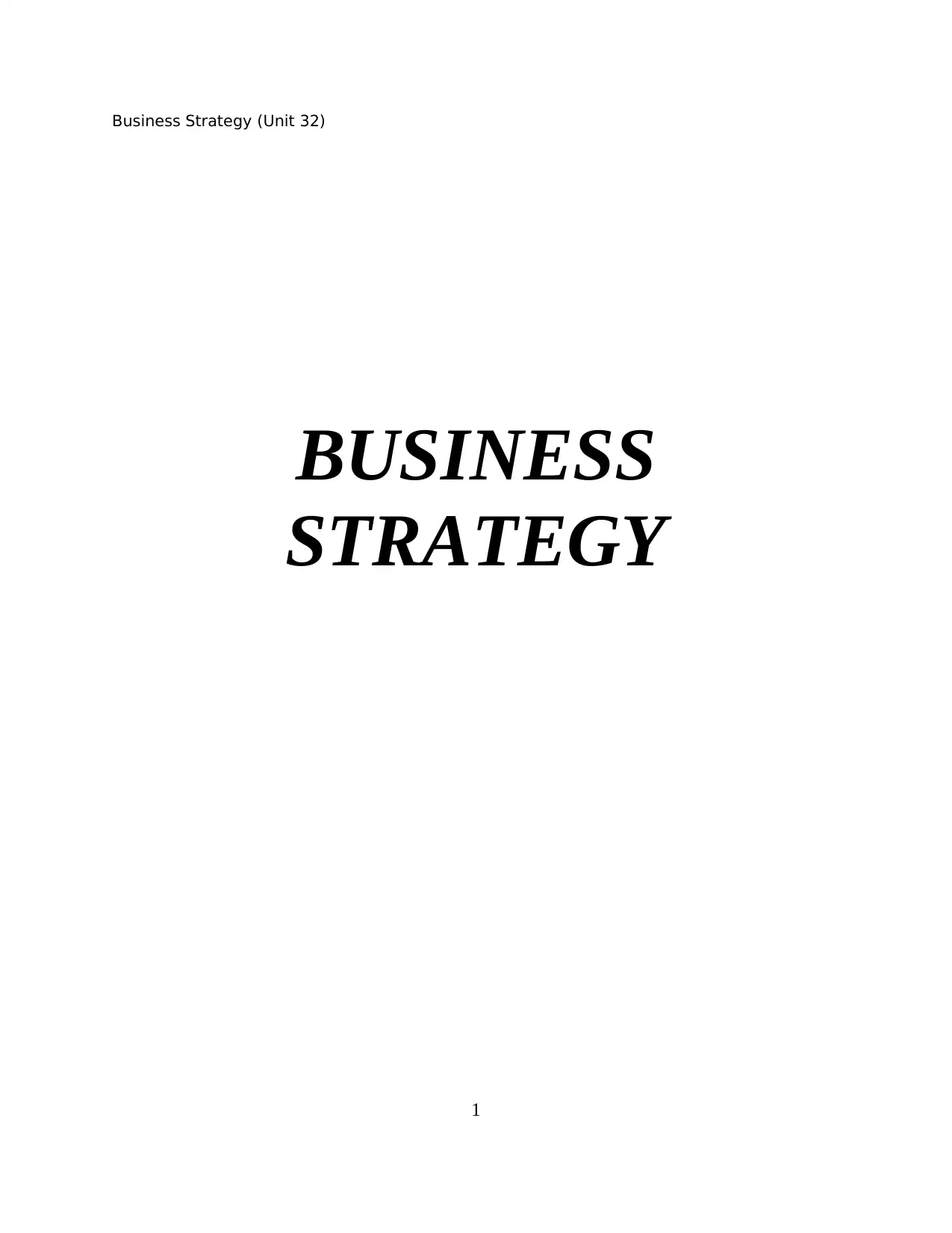
Business Strategy (Unit 32)
BUSINESS
STRATEGY
1
BUSINESS
STRATEGY
1
Paraphrase This Document
Need a fresh take? Get an instant paraphrase of this document with our AI Paraphraser
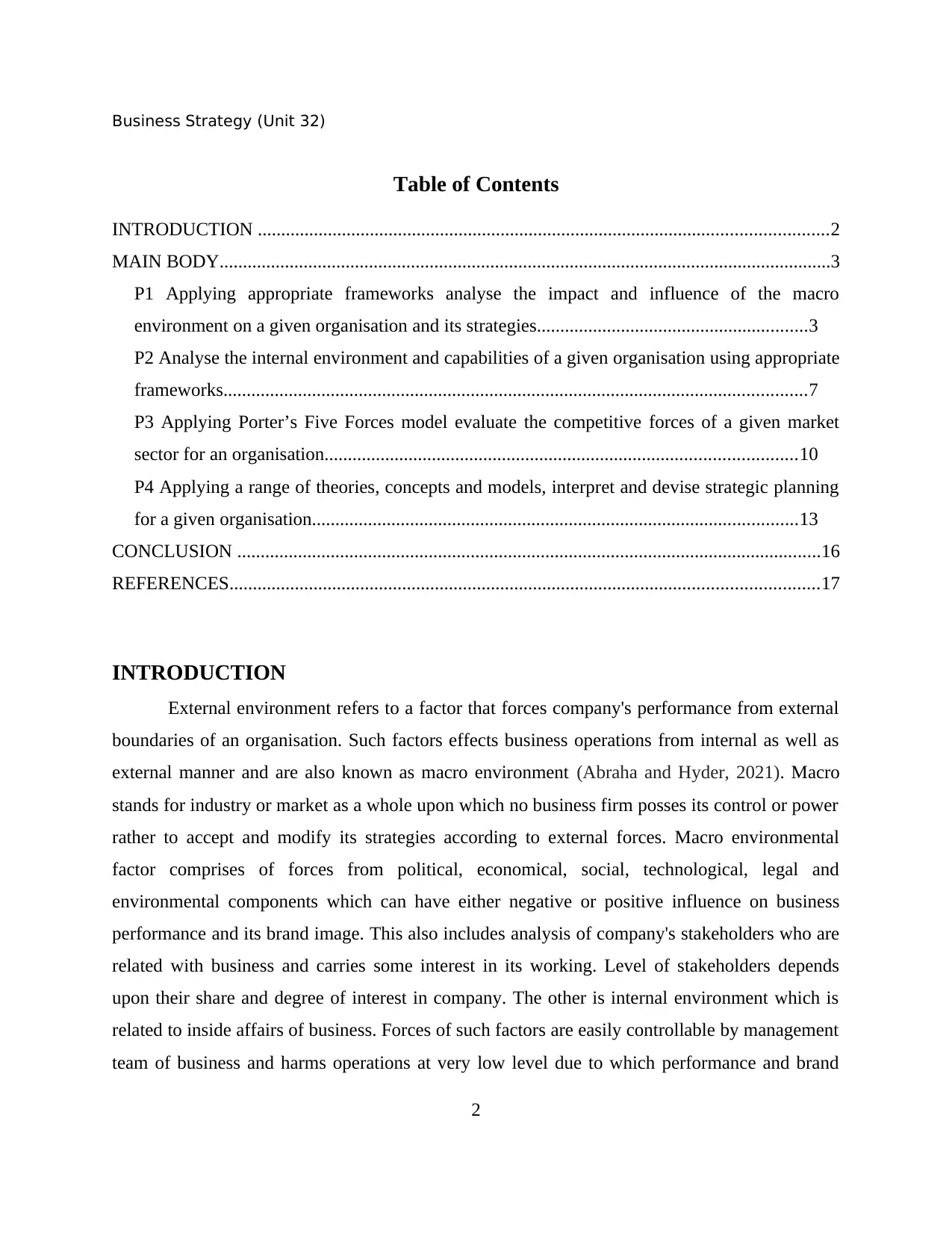
Business Strategy (Unit 32)
Table of Contents
INTRODUCTION ..........................................................................................................................2
MAIN BODY...................................................................................................................................3
P1 Applying appropriate frameworks analyse the impact and influence of the macro
environment on a given organisation and its strategies..........................................................3
P2 Analyse the internal environment and capabilities of a given organisation using appropriate
frameworks.............................................................................................................................7
P3 Applying Porter’s Five Forces model evaluate the competitive forces of a given market
sector for an organisation.....................................................................................................10
P4 Applying a range of theories, concepts and models, interpret and devise strategic planning
for a given organisation........................................................................................................13
CONCLUSION .............................................................................................................................16
REFERENCES..............................................................................................................................17
INTRODUCTION
External environment refers to a factor that forces company's performance from external
boundaries of an organisation. Such factors effects business operations from internal as well as
external manner and are also known as macro environment (Abraha and Hyder, 2021). Macro
stands for industry or market as a whole upon which no business firm posses its control or power
rather to accept and modify its strategies according to external forces. Macro environmental
factor comprises of forces from political, economical, social, technological, legal and
environmental components which can have either negative or positive influence on business
performance and its brand image. This also includes analysis of company's stakeholders who are
related with business and carries some interest in its working. Level of stakeholders depends
upon their share and degree of interest in company. The other is internal environment which is
related to inside affairs of business. Forces of such factors are easily controllable by management
team of business and harms operations at very low level due to which performance and brand
2
Table of Contents
INTRODUCTION ..........................................................................................................................2
MAIN BODY...................................................................................................................................3
P1 Applying appropriate frameworks analyse the impact and influence of the macro
environment on a given organisation and its strategies..........................................................3
P2 Analyse the internal environment and capabilities of a given organisation using appropriate
frameworks.............................................................................................................................7
P3 Applying Porter’s Five Forces model evaluate the competitive forces of a given market
sector for an organisation.....................................................................................................10
P4 Applying a range of theories, concepts and models, interpret and devise strategic planning
for a given organisation........................................................................................................13
CONCLUSION .............................................................................................................................16
REFERENCES..............................................................................................................................17
INTRODUCTION
External environment refers to a factor that forces company's performance from external
boundaries of an organisation. Such factors effects business operations from internal as well as
external manner and are also known as macro environment (Abraha and Hyder, 2021). Macro
stands for industry or market as a whole upon which no business firm posses its control or power
rather to accept and modify its strategies according to external forces. Macro environmental
factor comprises of forces from political, economical, social, technological, legal and
environmental components which can have either negative or positive influence on business
performance and its brand image. This also includes analysis of company's stakeholders who are
related with business and carries some interest in its working. Level of stakeholders depends
upon their share and degree of interest in company. The other is internal environment which is
related to inside affairs of business. Forces of such factors are easily controllable by management
team of business and harms operations at very low level due to which performance and brand
2
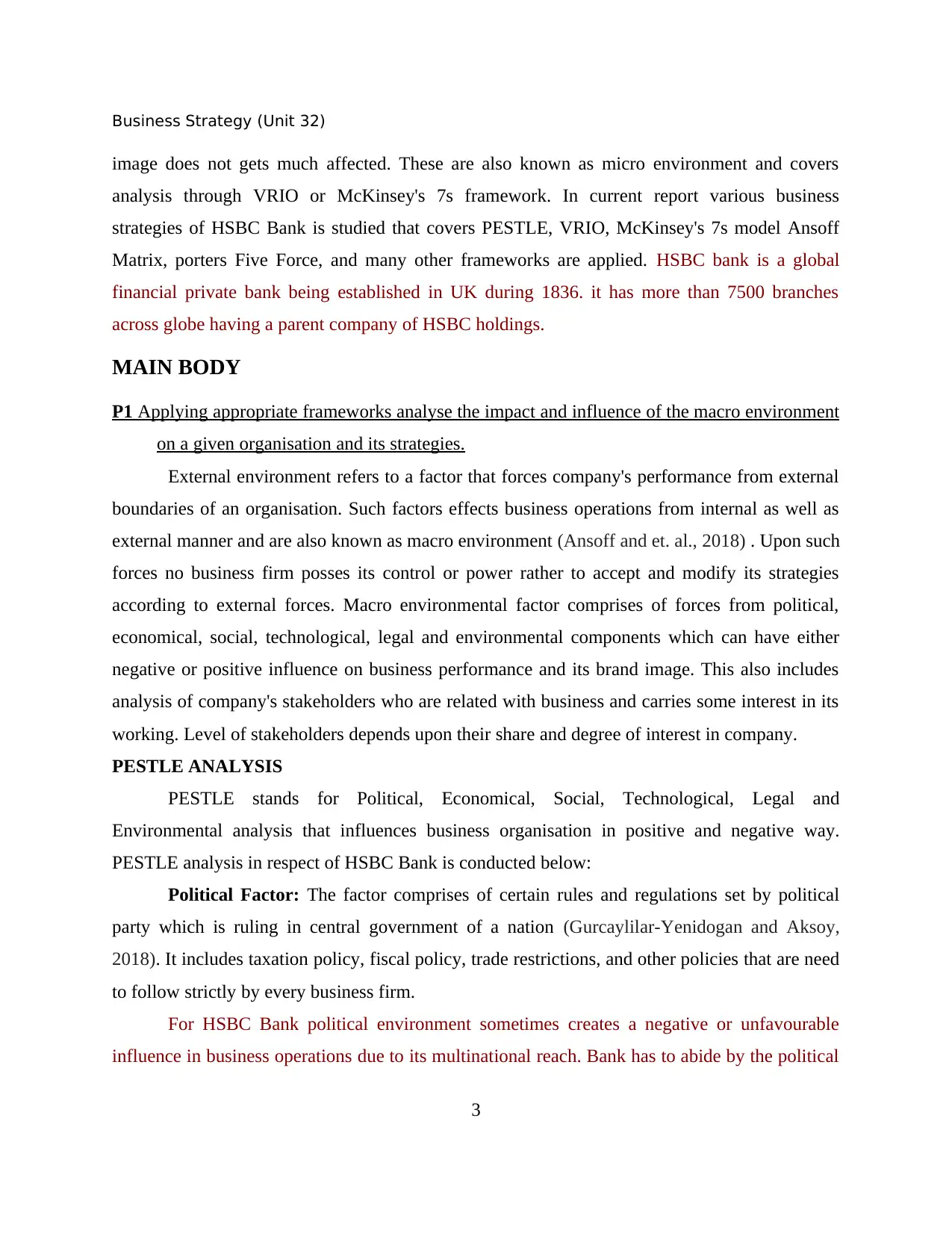
Business Strategy (Unit 32)
image does not gets much affected. These are also known as micro environment and covers
analysis through VRIO or McKinsey's 7s framework. In current report various business
strategies of HSBC Bank is studied that covers PESTLE, VRIO, McKinsey's 7s model Ansoff
Matrix, porters Five Force, and many other frameworks are applied. HSBC bank is a global
financial private bank being established in UK during 1836. it has more than 7500 branches
across globe having a parent company of HSBC holdings.
MAIN BODY
P1 Applying appropriate frameworks analyse the impact and influence of the macro environment
on a given organisation and its strategies.
External environment refers to a factor that forces company's performance from external
boundaries of an organisation. Such factors effects business operations from internal as well as
external manner and are also known as macro environment (Ansoff and et. al., 2018) . Upon such
forces no business firm posses its control or power rather to accept and modify its strategies
according to external forces. Macro environmental factor comprises of forces from political,
economical, social, technological, legal and environmental components which can have either
negative or positive influence on business performance and its brand image. This also includes
analysis of company's stakeholders who are related with business and carries some interest in its
working. Level of stakeholders depends upon their share and degree of interest in company.
PESTLE ANALYSIS
PESTLE stands for Political, Economical, Social, Technological, Legal and
Environmental analysis that influences business organisation in positive and negative way.
PESTLE analysis in respect of HSBC Bank is conducted below:
Political Factor: The factor comprises of certain rules and regulations set by political
party which is ruling in central government of a nation (Gurcaylilar-Yenidogan and Aksoy,
2018). It includes taxation policy, fiscal policy, trade restrictions, and other policies that are need
to follow strictly by every business firm.
For HSBC Bank political environment sometimes creates a negative or unfavourable
influence in business operations due to its multinational reach. Bank has to abide by the political
3
image does not gets much affected. These are also known as micro environment and covers
analysis through VRIO or McKinsey's 7s framework. In current report various business
strategies of HSBC Bank is studied that covers PESTLE, VRIO, McKinsey's 7s model Ansoff
Matrix, porters Five Force, and many other frameworks are applied. HSBC bank is a global
financial private bank being established in UK during 1836. it has more than 7500 branches
across globe having a parent company of HSBC holdings.
MAIN BODY
P1 Applying appropriate frameworks analyse the impact and influence of the macro environment
on a given organisation and its strategies.
External environment refers to a factor that forces company's performance from external
boundaries of an organisation. Such factors effects business operations from internal as well as
external manner and are also known as macro environment (Ansoff and et. al., 2018) . Upon such
forces no business firm posses its control or power rather to accept and modify its strategies
according to external forces. Macro environmental factor comprises of forces from political,
economical, social, technological, legal and environmental components which can have either
negative or positive influence on business performance and its brand image. This also includes
analysis of company's stakeholders who are related with business and carries some interest in its
working. Level of stakeholders depends upon their share and degree of interest in company.
PESTLE ANALYSIS
PESTLE stands for Political, Economical, Social, Technological, Legal and
Environmental analysis that influences business organisation in positive and negative way.
PESTLE analysis in respect of HSBC Bank is conducted below:
Political Factor: The factor comprises of certain rules and regulations set by political
party which is ruling in central government of a nation (Gurcaylilar-Yenidogan and Aksoy,
2018). It includes taxation policy, fiscal policy, trade restrictions, and other policies that are need
to follow strictly by every business firm.
For HSBC Bank political environment sometimes creates a negative or unfavourable
influence in business operations due to its multinational reach. Bank has to abide by the political
3
⊘ This is a preview!⊘
Do you want full access?
Subscribe today to unlock all pages.

Trusted by 1+ million students worldwide

Business Strategy (Unit 32)
rules of each country which is not an easy task for company to apply. Another issue is of
political instability in country which brings several changes in set policies upon which acting
immediately is a tedious task for organisations and hard to have smooth functioning of business.
Economical Factor: This factor of macro environment talks about country's economic
condition and issues related to it (Hamilton and Webster, 2018). It discusses about poverty and
unemployment, inflation and exchange rate system, growth rate, purchasing power of country
people, etc.
HSBC Bank faces huge problem in policies related to interest and exchange rate
systems. Since every country is having its own policy in this regard which is different from its
headquarter country. This creates a problem in value of currency which bank does not gets at fair
rate. HSBC also gets affected from stock market which changes in every second across globe.
On the other hand some countries proves beneficial for bank in terms of growth synchronization
which helps to generate high revenue in their regions through commercial banking practices. The
concern for currency exchange also hinders the profitability of bank as due to multinational
operations the value of currency differs from country to country which is not static and hence is
hard to equate.
Social Factor: The next force from external environment comprises of society's
preference, ethics or morals, demographics, culture, tradition, etc. since every company survives
in a society so it creates a big impact on business image.
HSBC bank gets positive influence from society after launching of HSBC educational
program for public which is very well accepted by society people. On the other hand bank enjoys
government support as they promotes small and medium enterprises which are beneficial for
HSBC to generate higher revenues (Hamutoglu and Basarmak, 2020).
Technological Factor: Forces of technological environment such as changes in technical
software, equipments, innovation, enhancement of existing technology, etc. plays a major role in
business operations of a company because the world demands technological up-gradation or
innovation frequently (Hanifah and et. Al ., 2019).
HSBC always fights with technological change as it needs to indulge technique of
automation or digitisation into its business to compete with its competitors who are already using
4
rules of each country which is not an easy task for company to apply. Another issue is of
political instability in country which brings several changes in set policies upon which acting
immediately is a tedious task for organisations and hard to have smooth functioning of business.
Economical Factor: This factor of macro environment talks about country's economic
condition and issues related to it (Hamilton and Webster, 2018). It discusses about poverty and
unemployment, inflation and exchange rate system, growth rate, purchasing power of country
people, etc.
HSBC Bank faces huge problem in policies related to interest and exchange rate
systems. Since every country is having its own policy in this regard which is different from its
headquarter country. This creates a problem in value of currency which bank does not gets at fair
rate. HSBC also gets affected from stock market which changes in every second across globe.
On the other hand some countries proves beneficial for bank in terms of growth synchronization
which helps to generate high revenue in their regions through commercial banking practices. The
concern for currency exchange also hinders the profitability of bank as due to multinational
operations the value of currency differs from country to country which is not static and hence is
hard to equate.
Social Factor: The next force from external environment comprises of society's
preference, ethics or morals, demographics, culture, tradition, etc. since every company survives
in a society so it creates a big impact on business image.
HSBC bank gets positive influence from society after launching of HSBC educational
program for public which is very well accepted by society people. On the other hand bank enjoys
government support as they promotes small and medium enterprises which are beneficial for
HSBC to generate higher revenues (Hamutoglu and Basarmak, 2020).
Technological Factor: Forces of technological environment such as changes in technical
software, equipments, innovation, enhancement of existing technology, etc. plays a major role in
business operations of a company because the world demands technological up-gradation or
innovation frequently (Hanifah and et. Al ., 2019).
HSBC always fights with technological change as it needs to indulge technique of
automation or digitisation into its business to compete with its competitors who are already using
4
Paraphrase This Document
Need a fresh take? Get an instant paraphrase of this document with our AI Paraphraser
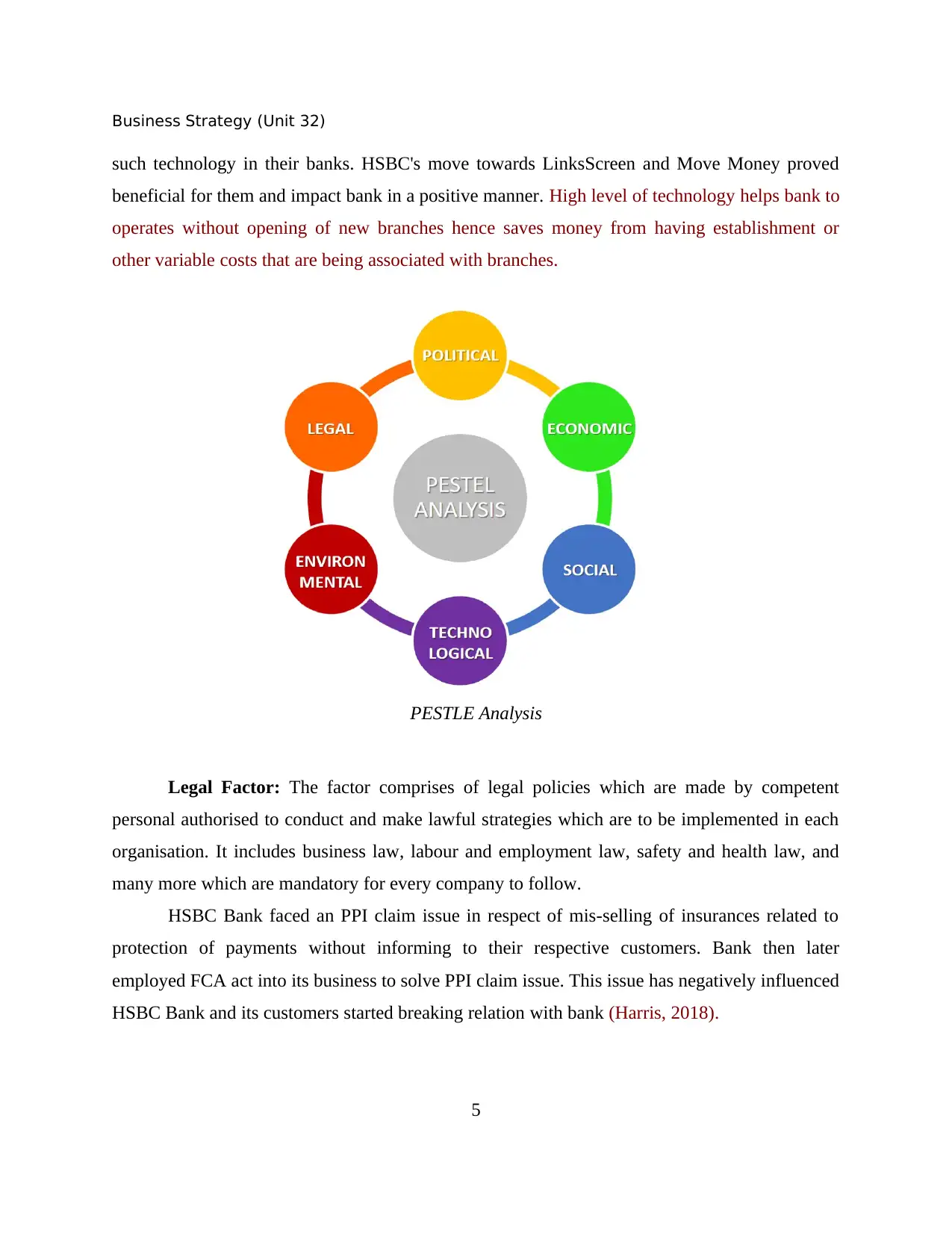
Business Strategy (Unit 32)
such technology in their banks. HSBC's move towards LinksScreen and Move Money proved
beneficial for them and impact bank in a positive manner. High level of technology helps bank to
operates without opening of new branches hence saves money from having establishment or
other variable costs that are being associated with branches.
Legal Factor: The factor comprises of legal policies which are made by competent
personal authorised to conduct and make lawful strategies which are to be implemented in each
organisation. It includes business law, labour and employment law, safety and health law, and
many more which are mandatory for every company to follow.
HSBC Bank faced an PPI claim issue in respect of mis-selling of insurances related to
protection of payments without informing to their respective customers. Bank then later
employed FCA act into its business to solve PPI claim issue. This issue has negatively influenced
HSBC Bank and its customers started breaking relation with bank (Harris, 2018).
5
PESTLE Analysis
such technology in their banks. HSBC's move towards LinksScreen and Move Money proved
beneficial for them and impact bank in a positive manner. High level of technology helps bank to
operates without opening of new branches hence saves money from having establishment or
other variable costs that are being associated with branches.
Legal Factor: The factor comprises of legal policies which are made by competent
personal authorised to conduct and make lawful strategies which are to be implemented in each
organisation. It includes business law, labour and employment law, safety and health law, and
many more which are mandatory for every company to follow.
HSBC Bank faced an PPI claim issue in respect of mis-selling of insurances related to
protection of payments without informing to their respective customers. Bank then later
employed FCA act into its business to solve PPI claim issue. This issue has negatively influenced
HSBC Bank and its customers started breaking relation with bank (Harris, 2018).
5
PESTLE Analysis
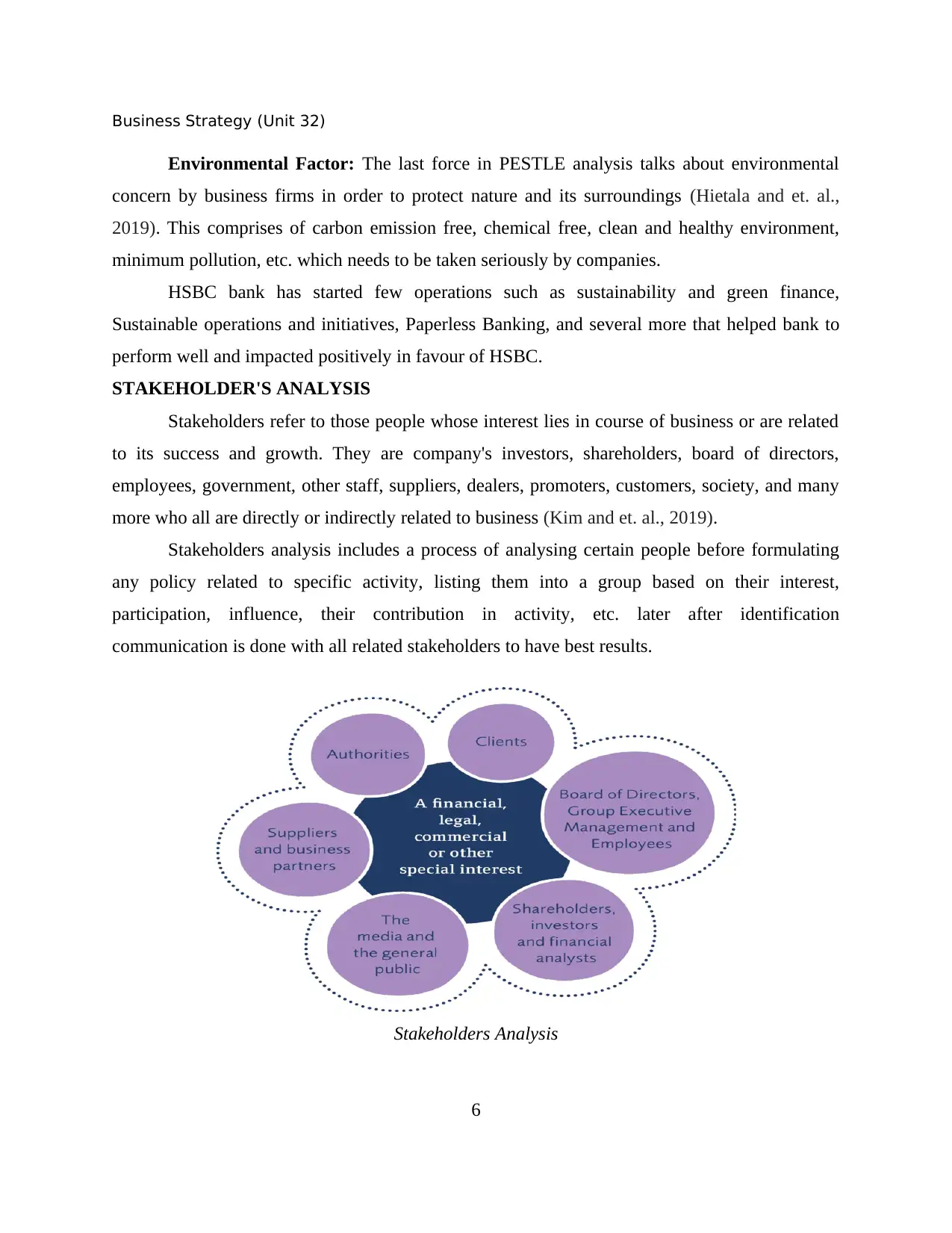
Business Strategy (Unit 32)
Environmental Factor: The last force in PESTLE analysis talks about environmental
concern by business firms in order to protect nature and its surroundings (Hietala and et. al.,
2019). This comprises of carbon emission free, chemical free, clean and healthy environment,
minimum pollution, etc. which needs to be taken seriously by companies.
HSBC bank has started few operations such as sustainability and green finance,
Sustainable operations and initiatives, Paperless Banking, and several more that helped bank to
perform well and impacted positively in favour of HSBC.
STAKEHOLDER'S ANALYSIS
Stakeholders refer to those people whose interest lies in course of business or are related
to its success and growth. They are company's investors, shareholders, board of directors,
employees, government, other staff, suppliers, dealers, promoters, customers, society, and many
more who all are directly or indirectly related to business (Kim and et. al., 2019).
Stakeholders analysis includes a process of analysing certain people before formulating
any policy related to specific activity, listing them into a group based on their interest,
participation, influence, their contribution in activity, etc. later after identification
communication is done with all related stakeholders to have best results.
6
Stakeholders Analysis
Environmental Factor: The last force in PESTLE analysis talks about environmental
concern by business firms in order to protect nature and its surroundings (Hietala and et. al.,
2019). This comprises of carbon emission free, chemical free, clean and healthy environment,
minimum pollution, etc. which needs to be taken seriously by companies.
HSBC bank has started few operations such as sustainability and green finance,
Sustainable operations and initiatives, Paperless Banking, and several more that helped bank to
perform well and impacted positively in favour of HSBC.
STAKEHOLDER'S ANALYSIS
Stakeholders refer to those people whose interest lies in course of business or are related
to its success and growth. They are company's investors, shareholders, board of directors,
employees, government, other staff, suppliers, dealers, promoters, customers, society, and many
more who all are directly or indirectly related to business (Kim and et. al., 2019).
Stakeholders analysis includes a process of analysing certain people before formulating
any policy related to specific activity, listing them into a group based on their interest,
participation, influence, their contribution in activity, etc. later after identification
communication is done with all related stakeholders to have best results.
6
Stakeholders Analysis
⊘ This is a preview!⊘
Do you want full access?
Subscribe today to unlock all pages.

Trusted by 1+ million students worldwide
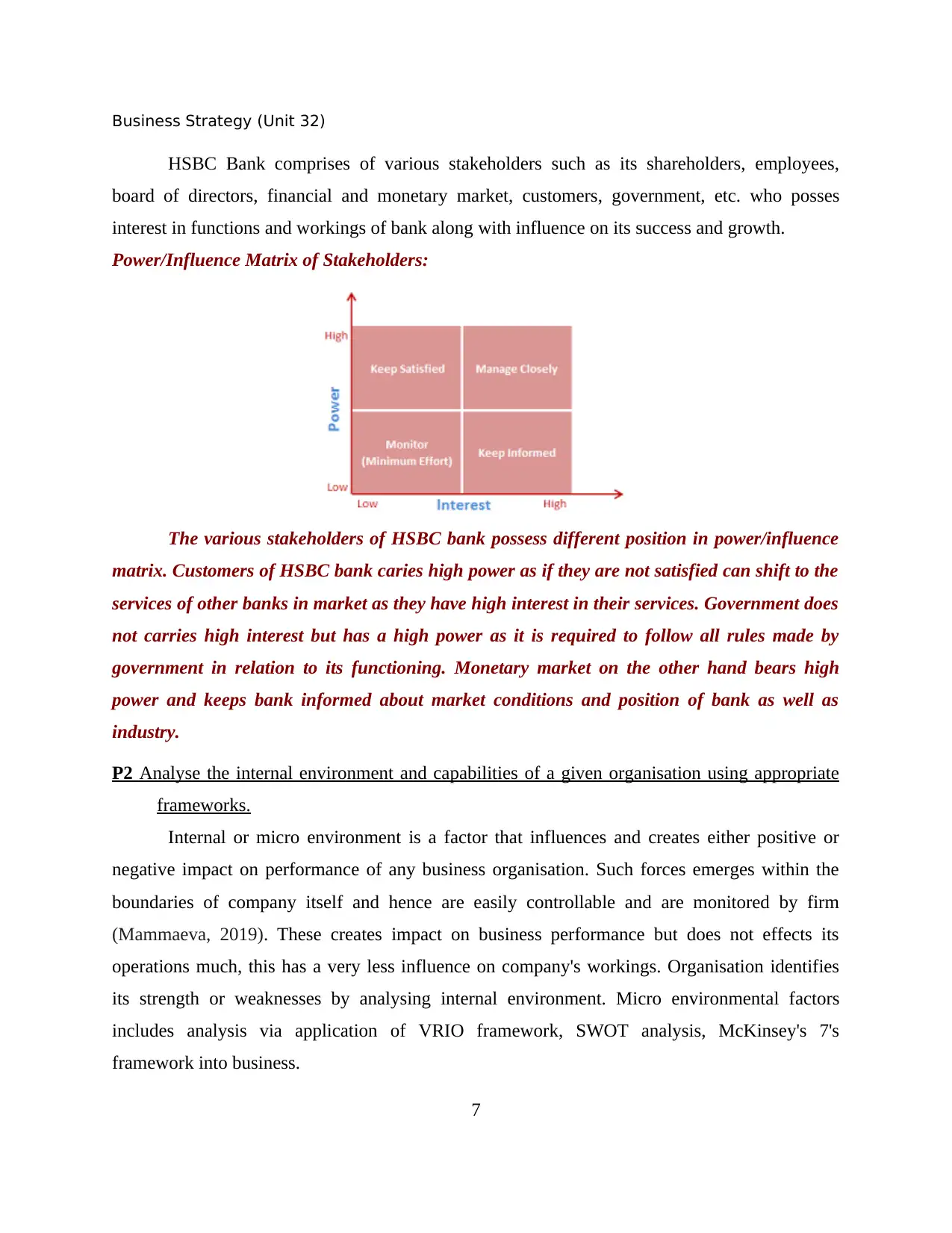
Business Strategy (Unit 32)
HSBC Bank comprises of various stakeholders such as its shareholders, employees,
board of directors, financial and monetary market, customers, government, etc. who posses
interest in functions and workings of bank along with influence on its success and growth.
Power/Influence Matrix of Stakeholders:
The various stakeholders of HSBC bank possess different position in power/influence
matrix. Customers of HSBC bank caries high power as if they are not satisfied can shift to the
services of other banks in market as they have high interest in their services. Government does
not carries high interest but has a high power as it is required to follow all rules made by
government in relation to its functioning. Monetary market on the other hand bears high
power and keeps bank informed about market conditions and position of bank as well as
industry.
P2 Analyse the internal environment and capabilities of a given organisation using appropriate
frameworks.
Internal or micro environment is a factor that influences and creates either positive or
negative impact on performance of any business organisation. Such forces emerges within the
boundaries of company itself and hence are easily controllable and are monitored by firm
(Mammaeva, 2019). These creates impact on business performance but does not effects its
operations much, this has a very less influence on company's workings. Organisation identifies
its strength or weaknesses by analysing internal environment. Micro environmental factors
includes analysis via application of VRIO framework, SWOT analysis, McKinsey's 7's
framework into business.
7
HSBC Bank comprises of various stakeholders such as its shareholders, employees,
board of directors, financial and monetary market, customers, government, etc. who posses
interest in functions and workings of bank along with influence on its success and growth.
Power/Influence Matrix of Stakeholders:
The various stakeholders of HSBC bank possess different position in power/influence
matrix. Customers of HSBC bank caries high power as if they are not satisfied can shift to the
services of other banks in market as they have high interest in their services. Government does
not carries high interest but has a high power as it is required to follow all rules made by
government in relation to its functioning. Monetary market on the other hand bears high
power and keeps bank informed about market conditions and position of bank as well as
industry.
P2 Analyse the internal environment and capabilities of a given organisation using appropriate
frameworks.
Internal or micro environment is a factor that influences and creates either positive or
negative impact on performance of any business organisation. Such forces emerges within the
boundaries of company itself and hence are easily controllable and are monitored by firm
(Mammaeva, 2019). These creates impact on business performance but does not effects its
operations much, this has a very less influence on company's workings. Organisation identifies
its strength or weaknesses by analysing internal environment. Micro environmental factors
includes analysis via application of VRIO framework, SWOT analysis, McKinsey's 7's
framework into business.
7
Paraphrase This Document
Need a fresh take? Get an instant paraphrase of this document with our AI Paraphraser
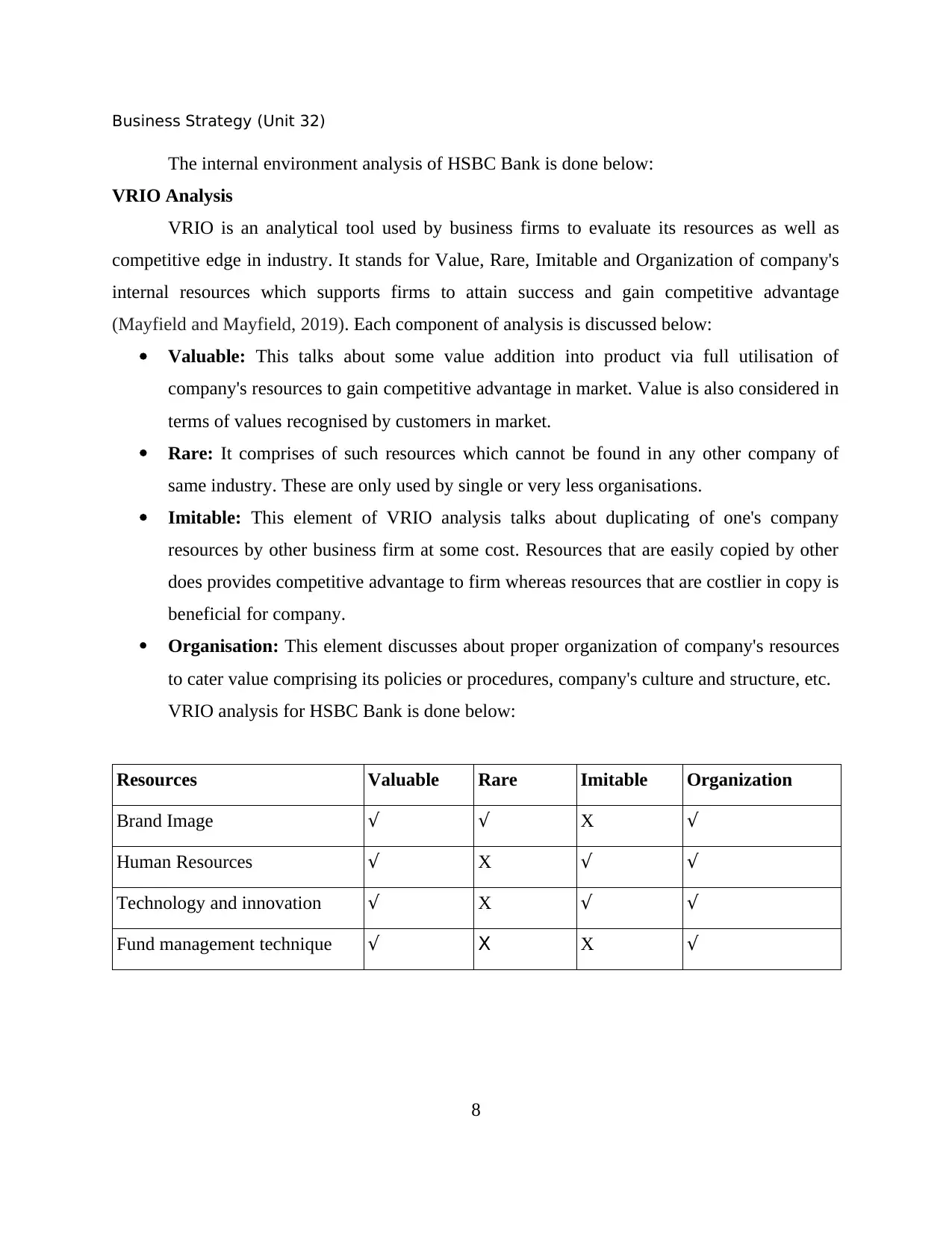
Business Strategy (Unit 32)
The internal environment analysis of HSBC Bank is done below:
VRIO Analysis
VRIO is an analytical tool used by business firms to evaluate its resources as well as
competitive edge in industry. It stands for Value, Rare, Imitable and Organization of company's
internal resources which supports firms to attain success and gain competitive advantage
(Mayfield and Mayfield, 2019). Each component of analysis is discussed below:
Valuable: This talks about some value addition into product via full utilisation of
company's resources to gain competitive advantage in market. Value is also considered in
terms of values recognised by customers in market.
Rare: It comprises of such resources which cannot be found in any other company of
same industry. These are only used by single or very less organisations.
Imitable: This element of VRIO analysis talks about duplicating of one's company
resources by other business firm at some cost. Resources that are easily copied by other
does provides competitive advantage to firm whereas resources that are costlier in copy is
beneficial for company.
Organisation: This element discusses about proper organization of company's resources
to cater value comprising its policies or procedures, company's culture and structure, etc.
VRIO analysis for HSBC Bank is done below:
Resources Valuable Rare Imitable Organization
Brand Image √ √ X √
Human Resources √ X √ √
Technology and innovation √ X √ √
Fund management technique √ X X √
8
The internal environment analysis of HSBC Bank is done below:
VRIO Analysis
VRIO is an analytical tool used by business firms to evaluate its resources as well as
competitive edge in industry. It stands for Value, Rare, Imitable and Organization of company's
internal resources which supports firms to attain success and gain competitive advantage
(Mayfield and Mayfield, 2019). Each component of analysis is discussed below:
Valuable: This talks about some value addition into product via full utilisation of
company's resources to gain competitive advantage in market. Value is also considered in
terms of values recognised by customers in market.
Rare: It comprises of such resources which cannot be found in any other company of
same industry. These are only used by single or very less organisations.
Imitable: This element of VRIO analysis talks about duplicating of one's company
resources by other business firm at some cost. Resources that are easily copied by other
does provides competitive advantage to firm whereas resources that are costlier in copy is
beneficial for company.
Organisation: This element discusses about proper organization of company's resources
to cater value comprising its policies or procedures, company's culture and structure, etc.
VRIO analysis for HSBC Bank is done below:
Resources Valuable Rare Imitable Organization
Brand Image √ √ X √
Human Resources √ X √ √
Technology and innovation √ X √ √
Fund management technique √ X X √
8
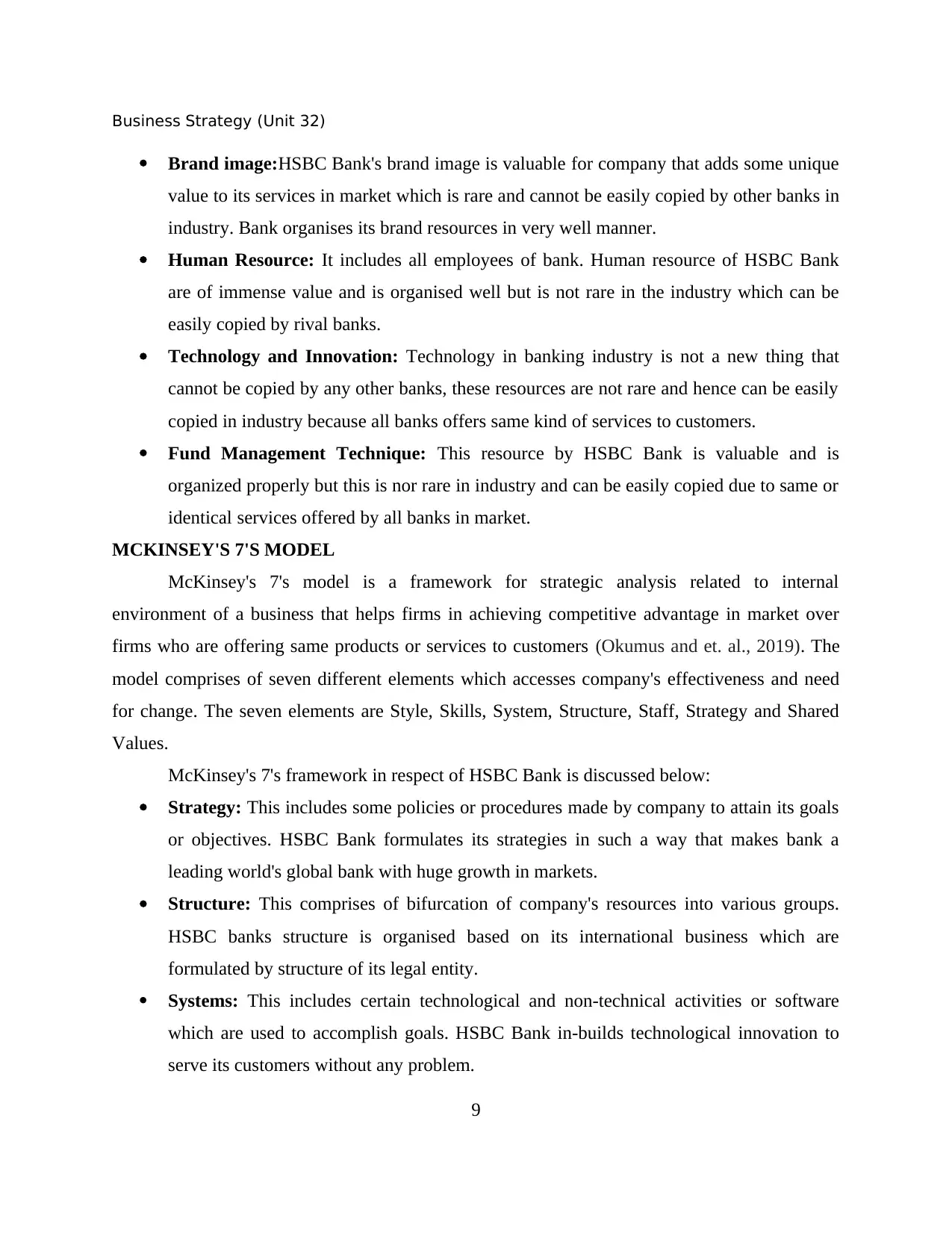
Business Strategy (Unit 32)
Brand image:HSBC Bank's brand image is valuable for company that adds some unique
value to its services in market which is rare and cannot be easily copied by other banks in
industry. Bank organises its brand resources in very well manner.
Human Resource: It includes all employees of bank. Human resource of HSBC Bank
are of immense value and is organised well but is not rare in the industry which can be
easily copied by rival banks.
Technology and Innovation: Technology in banking industry is not a new thing that
cannot be copied by any other banks, these resources are not rare and hence can be easily
copied in industry because all banks offers same kind of services to customers.
Fund Management Technique: This resource by HSBC Bank is valuable and is
organized properly but this is nor rare in industry and can be easily copied due to same or
identical services offered by all banks in market.
MCKINSEY'S 7'S MODEL
McKinsey's 7's model is a framework for strategic analysis related to internal
environment of a business that helps firms in achieving competitive advantage in market over
firms who are offering same products or services to customers (Okumus and et. al., 2019). The
model comprises of seven different elements which accesses company's effectiveness and need
for change. The seven elements are Style, Skills, System, Structure, Staff, Strategy and Shared
Values.
McKinsey's 7's framework in respect of HSBC Bank is discussed below:
Strategy: This includes some policies or procedures made by company to attain its goals
or objectives. HSBC Bank formulates its strategies in such a way that makes bank a
leading world's global bank with huge growth in markets.
Structure: This comprises of bifurcation of company's resources into various groups.
HSBC banks structure is organised based on its international business which are
formulated by structure of its legal entity.
Systems: This includes certain technological and non-technical activities or software
which are used to accomplish goals. HSBC Bank in-builds technological innovation to
serve its customers without any problem.
9
Brand image:HSBC Bank's brand image is valuable for company that adds some unique
value to its services in market which is rare and cannot be easily copied by other banks in
industry. Bank organises its brand resources in very well manner.
Human Resource: It includes all employees of bank. Human resource of HSBC Bank
are of immense value and is organised well but is not rare in the industry which can be
easily copied by rival banks.
Technology and Innovation: Technology in banking industry is not a new thing that
cannot be copied by any other banks, these resources are not rare and hence can be easily
copied in industry because all banks offers same kind of services to customers.
Fund Management Technique: This resource by HSBC Bank is valuable and is
organized properly but this is nor rare in industry and can be easily copied due to same or
identical services offered by all banks in market.
MCKINSEY'S 7'S MODEL
McKinsey's 7's model is a framework for strategic analysis related to internal
environment of a business that helps firms in achieving competitive advantage in market over
firms who are offering same products or services to customers (Okumus and et. al., 2019). The
model comprises of seven different elements which accesses company's effectiveness and need
for change. The seven elements are Style, Skills, System, Structure, Staff, Strategy and Shared
Values.
McKinsey's 7's framework in respect of HSBC Bank is discussed below:
Strategy: This includes some policies or procedures made by company to attain its goals
or objectives. HSBC Bank formulates its strategies in such a way that makes bank a
leading world's global bank with huge growth in markets.
Structure: This comprises of bifurcation of company's resources into various groups.
HSBC banks structure is organised based on its international business which are
formulated by structure of its legal entity.
Systems: This includes certain technological and non-technical activities or software
which are used to accomplish goals. HSBC Bank in-builds technological innovation to
serve its customers without any problem.
9
⊘ This is a preview!⊘
Do you want full access?
Subscribe today to unlock all pages.

Trusted by 1+ million students worldwide
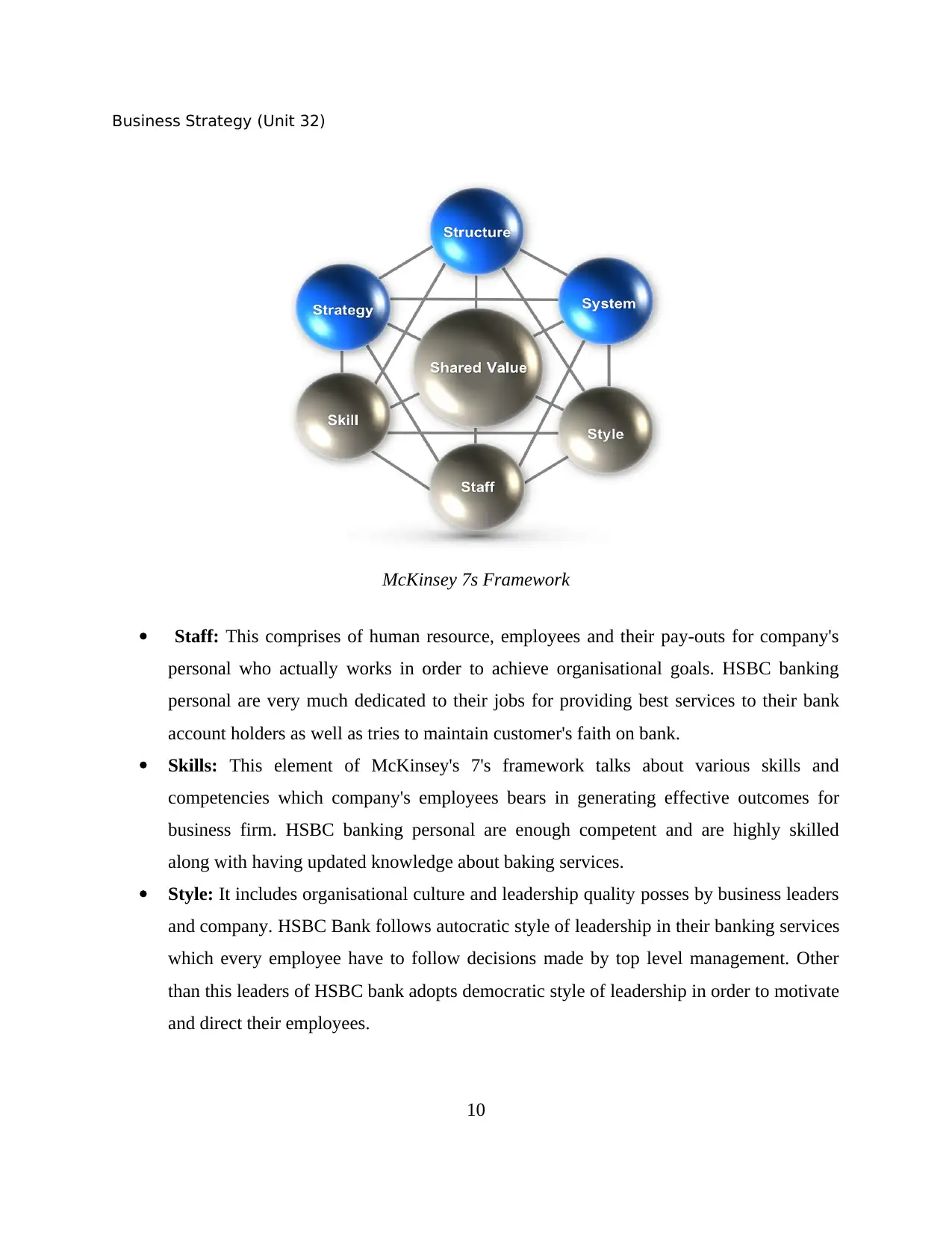
Business Strategy (Unit 32)
Staff: This comprises of human resource, employees and their pay-outs for company's
personal who actually works in order to achieve organisational goals. HSBC banking
personal are very much dedicated to their jobs for providing best services to their bank
account holders as well as tries to maintain customer's faith on bank.
Skills: This element of McKinsey's 7's framework talks about various skills and
competencies which company's employees bears in generating effective outcomes for
business firm. HSBC banking personal are enough competent and are highly skilled
along with having updated knowledge about baking services.
Style: It includes organisational culture and leadership quality posses by business leaders
and company. HSBC Bank follows autocratic style of leadership in their banking services
which every employee have to follow decisions made by top level management. Other
than this leaders of HSBC bank adopts democratic style of leadership in order to motivate
and direct their employees.
10
McKinsey 7s Framework
Staff: This comprises of human resource, employees and their pay-outs for company's
personal who actually works in order to achieve organisational goals. HSBC banking
personal are very much dedicated to their jobs for providing best services to their bank
account holders as well as tries to maintain customer's faith on bank.
Skills: This element of McKinsey's 7's framework talks about various skills and
competencies which company's employees bears in generating effective outcomes for
business firm. HSBC banking personal are enough competent and are highly skilled
along with having updated knowledge about baking services.
Style: It includes organisational culture and leadership quality posses by business leaders
and company. HSBC Bank follows autocratic style of leadership in their banking services
which every employee have to follow decisions made by top level management. Other
than this leaders of HSBC bank adopts democratic style of leadership in order to motivate
and direct their employees.
10
McKinsey 7s Framework
Paraphrase This Document
Need a fresh take? Get an instant paraphrase of this document with our AI Paraphraser
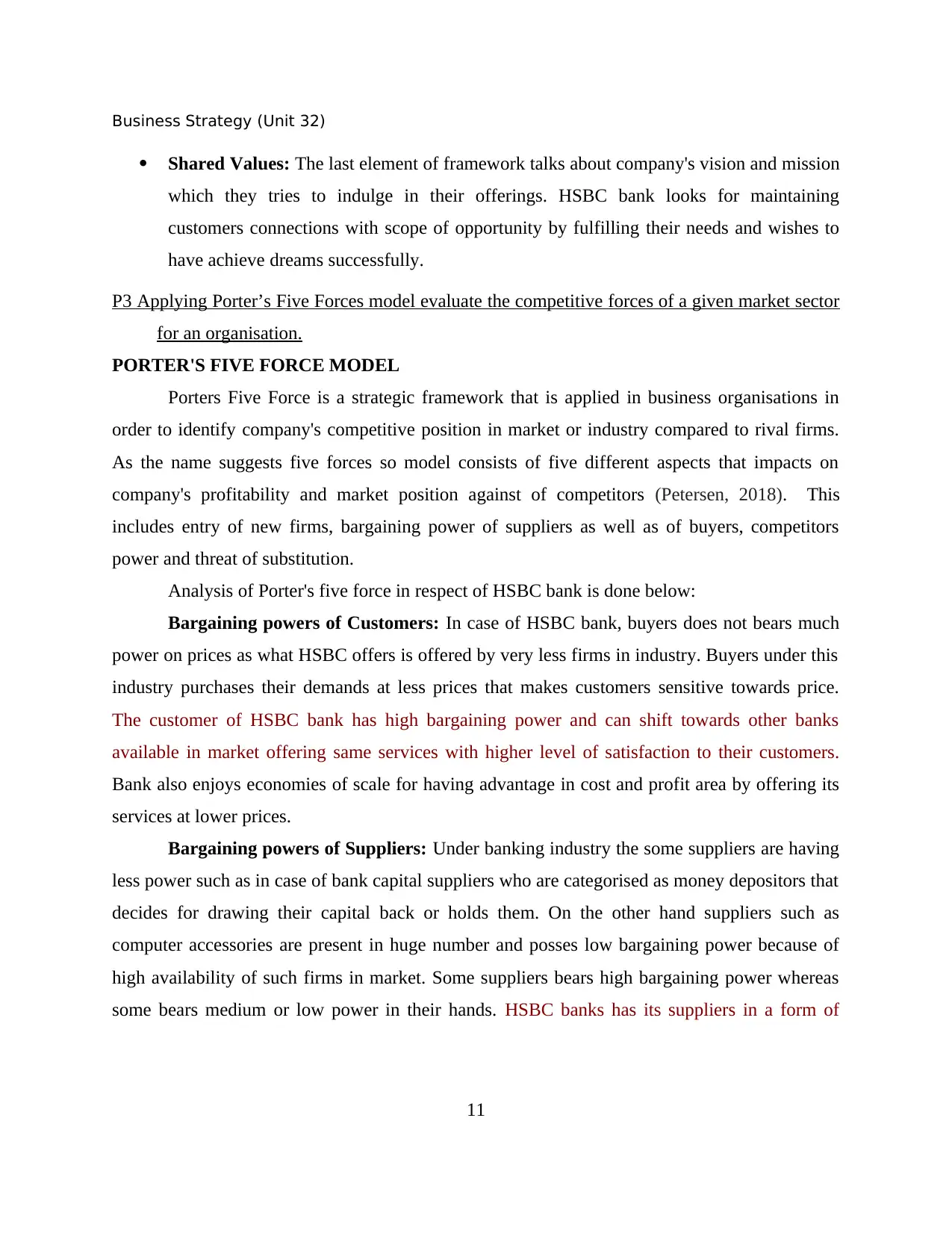
Business Strategy (Unit 32)
Shared Values: The last element of framework talks about company's vision and mission
which they tries to indulge in their offerings. HSBC bank looks for maintaining
customers connections with scope of opportunity by fulfilling their needs and wishes to
have achieve dreams successfully.
P3 Applying Porter’s Five Forces model evaluate the competitive forces of a given market sector
for an organisation.
PORTER'S FIVE FORCE MODEL
Porters Five Force is a strategic framework that is applied in business organisations in
order to identify company's competitive position in market or industry compared to rival firms.
As the name suggests five forces so model consists of five different aspects that impacts on
company's profitability and market position against of competitors (Petersen, 2018). This
includes entry of new firms, bargaining power of suppliers as well as of buyers, competitors
power and threat of substitution.
Analysis of Porter's five force in respect of HSBC bank is done below:
Bargaining powers of Customers: In case of HSBC bank, buyers does not bears much
power on prices as what HSBC offers is offered by very less firms in industry. Buyers under this
industry purchases their demands at less prices that makes customers sensitive towards price.
The customer of HSBC bank has high bargaining power and can shift towards other banks
available in market offering same services with higher level of satisfaction to their customers.
Bank also enjoys economies of scale for having advantage in cost and profit area by offering its
services at lower prices.
Bargaining powers of Suppliers: Under banking industry the some suppliers are having
less power such as in case of bank capital suppliers who are categorised as money depositors that
decides for drawing their capital back or holds them. On the other hand suppliers such as
computer accessories are present in huge number and posses low bargaining power because of
high availability of such firms in market. Some suppliers bears high bargaining power whereas
some bears medium or low power in their hands. HSBC banks has its suppliers in a form of
11
Shared Values: The last element of framework talks about company's vision and mission
which they tries to indulge in their offerings. HSBC bank looks for maintaining
customers connections with scope of opportunity by fulfilling their needs and wishes to
have achieve dreams successfully.
P3 Applying Porter’s Five Forces model evaluate the competitive forces of a given market sector
for an organisation.
PORTER'S FIVE FORCE MODEL
Porters Five Force is a strategic framework that is applied in business organisations in
order to identify company's competitive position in market or industry compared to rival firms.
As the name suggests five forces so model consists of five different aspects that impacts on
company's profitability and market position against of competitors (Petersen, 2018). This
includes entry of new firms, bargaining power of suppliers as well as of buyers, competitors
power and threat of substitution.
Analysis of Porter's five force in respect of HSBC bank is done below:
Bargaining powers of Customers: In case of HSBC bank, buyers does not bears much
power on prices as what HSBC offers is offered by very less firms in industry. Buyers under this
industry purchases their demands at less prices that makes customers sensitive towards price.
The customer of HSBC bank has high bargaining power and can shift towards other banks
available in market offering same services with higher level of satisfaction to their customers.
Bank also enjoys economies of scale for having advantage in cost and profit area by offering its
services at lower prices.
Bargaining powers of Suppliers: Under banking industry the some suppliers are having
less power such as in case of bank capital suppliers who are categorised as money depositors that
decides for drawing their capital back or holds them. On the other hand suppliers such as
computer accessories are present in huge number and posses low bargaining power because of
high availability of such firms in market. Some suppliers bears high bargaining power whereas
some bears medium or low power in their hands. HSBC banks has its suppliers in a form of
11
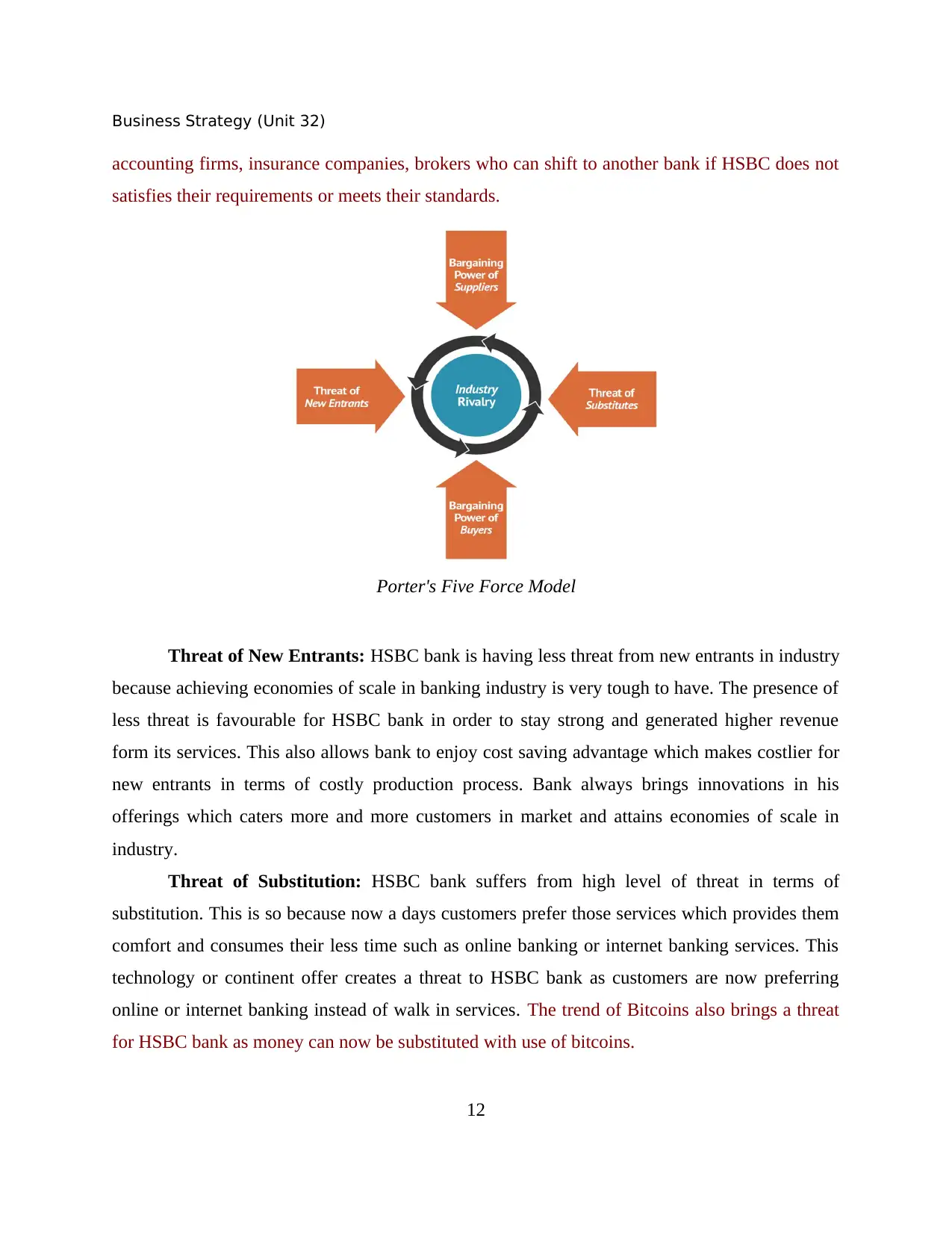
Business Strategy (Unit 32)
accounting firms, insurance companies, brokers who can shift to another bank if HSBC does not
satisfies their requirements or meets their standards.
Threat of New Entrants: HSBC bank is having less threat from new entrants in industry
because achieving economies of scale in banking industry is very tough to have. The presence of
less threat is favourable for HSBC bank in order to stay strong and generated higher revenue
form its services. This also allows bank to enjoy cost saving advantage which makes costlier for
new entrants in terms of costly production process. Bank always brings innovations in his
offerings which caters more and more customers in market and attains economies of scale in
industry.
Threat of Substitution: HSBC bank suffers from high level of threat in terms of
substitution. This is so because now a days customers prefer those services which provides them
comfort and consumes their less time such as online banking or internet banking services. This
technology or continent offer creates a threat to HSBC bank as customers are now preferring
online or internet banking instead of walk in services. The trend of Bitcoins also brings a threat
for HSBC bank as money can now be substituted with use of bitcoins.
12
Porter's Five Force Model
accounting firms, insurance companies, brokers who can shift to another bank if HSBC does not
satisfies their requirements or meets their standards.
Threat of New Entrants: HSBC bank is having less threat from new entrants in industry
because achieving economies of scale in banking industry is very tough to have. The presence of
less threat is favourable for HSBC bank in order to stay strong and generated higher revenue
form its services. This also allows bank to enjoy cost saving advantage which makes costlier for
new entrants in terms of costly production process. Bank always brings innovations in his
offerings which caters more and more customers in market and attains economies of scale in
industry.
Threat of Substitution: HSBC bank suffers from high level of threat in terms of
substitution. This is so because now a days customers prefer those services which provides them
comfort and consumes their less time such as online banking or internet banking services. This
technology or continent offer creates a threat to HSBC bank as customers are now preferring
online or internet banking instead of walk in services. The trend of Bitcoins also brings a threat
for HSBC bank as money can now be substituted with use of bitcoins.
12
Porter's Five Force Model
⊘ This is a preview!⊘
Do you want full access?
Subscribe today to unlock all pages.

Trusted by 1+ million students worldwide
1 out of 19
Related Documents
Your All-in-One AI-Powered Toolkit for Academic Success.
+13062052269
info@desklib.com
Available 24*7 on WhatsApp / Email
![[object Object]](/_next/static/media/star-bottom.7253800d.svg)
Unlock your academic potential
Copyright © 2020–2025 A2Z Services. All Rights Reserved. Developed and managed by ZUCOL.





